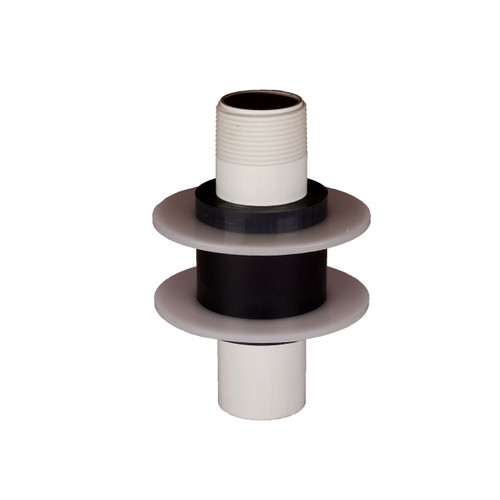Solid PVC Surge Block 2" Sch40
- SKU:
- SBM2
Plunger style Surge block that utilizes a solid piece of PVC with 2 rubber O-rings to create a seal around the casing. There is no developing port. Instead, it has 2 check valves on either side of the riser connector (3/4” NPT Female Pipe Thread) that allows for air to move below the surge block on the up-stroke without allowing water to escape on the down-stroke. This allows pressure to build inside the water formation while allowing you to easily retrieve the surge block after completion.
A surge block is a tight-fitting tool that fits against the inside of the well casing. The gap between the surge block and casing is tight enough to create a seal but loose enough to allow the block to travel up and down the casing. Acting like a plunger, the surge block forces water inside the well to recede back into the formation. In the case of a Well Developer, the same concept is used except the water is pushed up through a developer check valve and evacuated out of the well.
To effectively surge a well, apply an up and down motion, repeatedly raising and dropping the plunger 2 to 3 feet. While the plunger can be forced down on each stroke, adding weight just above the surge block will make it easier to work for a longer period of time.
Surging should start above the screen to reduce the possibility of "sand-locking" the surge block. Initial surging should be with a long stroke and at a slow rate (20 to 25 strokes per minute).
Monoflex Style Surge Block
-
Description
Plunger style Surge block that utilizes a solid piece of PVC with 2 rubber O-rings to create a seal around the casing. There is no developing port. Instead, it has 2 check valves on either side of the riser connector (3/4” NPT Female Pipe Thread) that allows for air to move below the surge block on the up-stroke without allowing water to escape on the down-stroke. This allows pressure to build inside the water formation while allowing you to easily retrieve the surge block after completion. A surge block is a tight-fitting tool that fits against the inside of the well casing. The gap between the surge block and casing is tight enough to create a seal but loose enough to allow the block to travel up and down the casing. Acting like a plunger, the surge block forces water inside the well to recede back into the formation. In the case of a Well Developer, the same concept is used except the water is pushed up through a developer check valve and evacuated out of the well. To effectively surge a well, apply an up and down motion, repeatedly raising and dropping the plunger 2 to 3 feet. While the plunger can be forced down on each stroke, adding weight just above the surge block will make it easier to work for a longer period of time. Surging should start above the screen to reduce the possibility of "sand-locking" the surge block. Initial surging should be with a long stroke and at a slow rate (20 to 25 strokes per minute). Monoflex Style Surge Block
-
Data Sheets
Plunger style Surge block that utilizes a solid piece of PVC with 2 rubber O-rings to create a seal around the casing. There is no developing port. Instead, it has 2 check valves on either side of the riser connector (3/4” NPT Female Pipe Thread) that allows for air to move below the surge block on the up-stroke without allowing water to escape on the down-stroke. This allows pressure to build inside the water formation while allowing you to easily retrieve the surge block after completion.
A surge block is a tight-fitting tool that fits against the inside of the well casing. The gap between the surge block and casing is tight enough to create a seal but loose enough to allow the block to travel up and down the casing. Acting like a plunger, the surge block forces water inside the well to recede back into the formation. In the case of a Well Developer, the same concept is used except the water is pushed up through a developer check valve and evacuated out of the well.
To effectively surge a well, apply an up and down motion, repeatedly raising and dropping the plunger 2 to 3 feet. While the plunger can be forced down on each stroke, adding weight just above the surge block will make it easier to work for a longer period of time.
Surging should start above the screen to reduce the possibility of "sand-locking" the surge block. Initial surging should be with a long stroke and at a slow rate (20 to 25 strokes per minute).
Monoflex Style Surge Block







